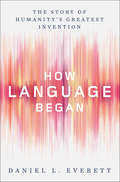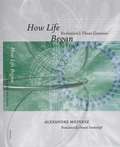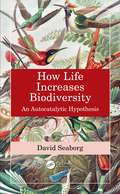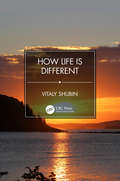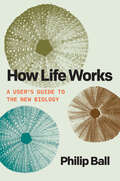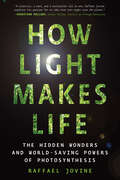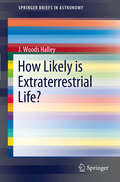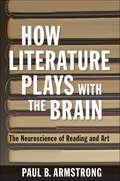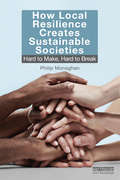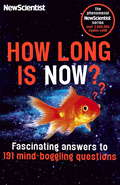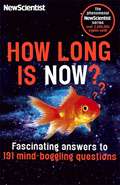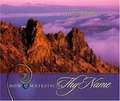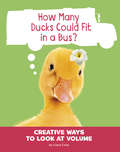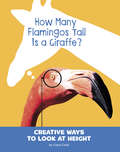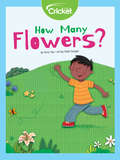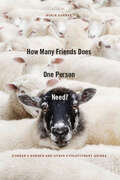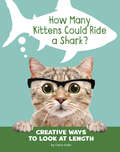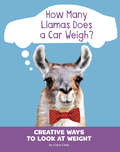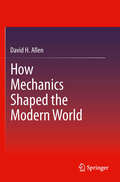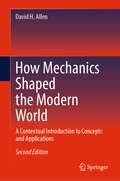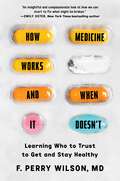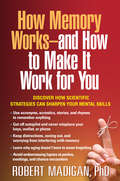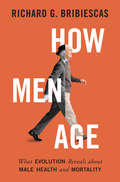- Table View
- List View
How Language Began: The Story Of Humanity's Greatest Invention
by Daniel L. EverettHow Language Began revolutionizes our understanding of the one tool that has allowed us to become the "lords of the planet." Mankind has a distinct advantage over other terrestrial species: we talk to one another. But how did we acquire the most advanced form of communication on Earth? Daniel L. Everett, a “bombshell” linguist and “instant folk hero” (Tom Wolfe, Harper’s), provides in this sweeping history a comprehensive examination of the evolutionary story of language, from the earliest speaking attempts by hominids to the more than seven thousand languages that exist today. Although fossil hunters and linguists have brought us closer to unearthing the true origins of language, Daniel Everett’s discoveries have upended the contemporary linguistic world, reverberating far beyond academic circles. While conducting field research in the Amazonian rainforest, Everett came across an age-old language nestled amongst a tribe of hunter-gatherers. Challenging long-standing principles in the field, Everett now builds on the theory that language was not intrinsic to our species. In order to truly understand its origins, a more interdisciplinary approach is needed—one that accounts as much for our propensity for culture as it does our biological makeup. Language began, Everett theorizes, with Homo Erectus, who catalyzed words through culturally invented symbols. Early humans, as their brains grew larger, incorporated gestures and voice intonations to communicate, all of which built on each other for 60,000 generations. Tracing crucial shifts and developments across the ages, Everett breaks down every component of speech, from harnessing control of more than a hundred respiratory muscles in the larynx and diaphragm, to mastering the use of the tongue. Moving on from biology to execution, Everett explores why elements such as grammar and storytelling are not nearly as critical to language as one might suspect. In the book’s final section, Cultural Evolution of Language, Everett takes the ever-debated “language gap” to task, delving into the chasm that separates “us” from “the animals.” He approaches the subject from various disciplines, including anthropology, neuroscience, and archaeology, to reveal that it was social complexity, as well as cultural, physiological, and neurological superiority, that allowed humans—with our clawless hands, breakable bones, and soft skin—to become the apex predator. How Language Began ultimately explains what we know, what we’d like to know, and what we likely never will know about how humans went from mere communication to language. Based on nearly forty years of fieldwork, Everett debunks long-held theories by some of history’s greatest thinkers, from Plato to Chomsky. The result is an invaluable study of what makes us human.
How Life Began: Evolution's Three Geneses
by Alexandre MeineszThe origin of life is a hotly debated topic. The Christian Bible states that God created the heavens and the Earth, all in about seven days roughly six thousand years ago. This episode in Genesis departs markedly from scientific theories developed over the last two centuries which hold that life appeared on Earth about 3.5 billion years ago in the form of bacteria, followed by unicellular organisms half a millennia later. It is this version of genesis that Alexandre Meinesz explores in this engaging tale of life's origins and evolution. How Life Began elucidates three origins, or geneses, of life—bacteria, nucleated cells, and multicellular organisms—and shows how evolution has sculpted life to its current biodiversity through four main events—mutation, recombination, natural selection, and geologic cataclysm. As an ecologist who specializes in algae, the first organisms to colonize Earth, Meinesz brings a refreshingly novel voice to the history of biodiversity and emphasizes here the role of unions in organizing life. For example, the ingestion of some bacteria by other bacteria led to mitochondria that characterize animal and plant cells, and the chloroplasts of plant cells. As Meinesz charmingly recounts, life’s grandeur is a result of an evolutionary tendency toward sociality and solidarity. He suggests that it is our cohesion and collaboration that allows us to solve the environmental problems arising in the decades and centuries to come. Rooted in the science of evolution but enlivened with many illustrations from other disciplines and the arts, How Life Began intertwines the rise of bacteria and multicellular life with Vermeer’s portrait of Antoni van Leeuwenhoek, the story of Genesis and Noah, Meinesz’s son’s early experiences with Legos, and his own encounters with other scientists. All of this brings a very human and humanistic tone to Meinesz’s charismatic narrative of the three origins of life.
How Life Began: Evolution’s Three Geneses
by Alexandre Meinesz Daniel SimberloffThe origin of life is a hotly debated topic. The Christian Bible states that God created the heavens and the Earth, all in about seven days roughly six thousand years ago. This episode in Genesis departs markedly from scientific theories developed over the last two centuries which hold that life appeared on Earth about 3 billion years ago in the form of bacteria, followed by unicellular organisms half a millennia later. It is this version of genesis that Alexandre Meinesz explores in this engaging tale of life's origins and evolution. How Life Began elucidates three origins, or geneses, of life-- bacteria, cells, and multicellular organisms-- and shows how evolution has sculpted life to its current biodiversity through four main events-- mutation, recombination, natural selection, and geologic cataclysm. As an ecologist who specializes in algae, the first organisms to colonize Earth, Meinesz brings a refreshingly novel voice to the history of biodiversity and emphasizes here the role of unions in organizing life. For example, the ingestion of some bacteria by other bacteria led to mitochondria that characterize animal and plant cells, and the chloroplasts of plant cells. As Meinesz charmingly recounts, life's grandeur is a result of an evolutionary tendency toward sociality and solidarity. He suggests that it is our cohesion and collaboration that allows us to solve the environmental problems arising in the decades and centuries to come. Rooted in the science of evolution but enlivened with many illustrations from other disciplines and the arts,How Life Began intertwines the rise of bacteria and multicellular life with Vermeer's portrait of Antoni van Leeuwenhoek, the story of Genesis and Noah, Meinesz's son's early experiences with Legos, and his own encounters with other scientists. All of this brings a very human and humanistic tone to Meinesz's charismatic narrative of the three origins of life.
How Life Increases Biodiversity: An Autocatalytic Hypothesis
by David SeaborgThis book argues that organisms and their interactions create and maximize biodiversity. The evidence for this autocatalytic hypothesis has been collated and integrated into this provocative argument. Natural selection favors the increase of biodiversity. Organisms can be causative agents contributing to major macroevolutionary transitions. Species tend to have a net positive effect on biodiversity. All species are ecosystem engineers. Mutualism and commensalism are common and fundamental, and these coevolved interspecific interactions frequently generate enormous increases in biodiversity. Competition generally does not decrease biodiversity, and often leads to evolutionary innovation. Plants are ecosystem engineers that have made Earth more favorable to life and increased diversity in many ways. Herbivores and predators increase the diversity of the species they consume, and are necessary for ecosystem stability. Decomposers are essential to ecosystem health. All these examples illustrate the focus of this book – that organisms and their interactions stimulate biodiversity, and ecosystems maximize it. Key Features • Describes a hypothesis that life itself generates higher biodiversity • Suggests a highly modified version of the established paradigm in population biology and evolution • Asserts that all species are ecosystem engineers with a net positive effect on biodiversity and their ecosystems • Suggests that mutualism and commensalism are the rule • Presents a novel view likely to elicit deeper discussions of biodiversity Related Titles Dewdney, A. K. Stochastic Communities: A Mathematical Theory of Biodiversity (ISBN 978-1-138-19702-2) Curry, G. B. and C. J. Humphries, eds. Biodiversity Databases: Techniques, Politics, and Applications (ISBN 978-0-367-38916-1) Pullaiah, T, ed. Global Biodiversity. 4 Volume Set (ISBN 978-1-77188-751-9)
How Life is Different
by Vitaly ShubinThe book examines basic principles of the structure and organization of living organisms and their differences from objects of inanimate nature. It covers how a single program-information structure permeates all evolutionary stages of life, including the cell, multicellular organisms and humans. The author explains how this structure is arranged and how it functions, as well as the role of the information system. KEY FEATURES Reviews persistent questions and addresses fundamental themes in biology Provides systematic coverage Includes original insights into basic principles of living organization and structure Demonstrates the applicability of a proposed approach to particular evolutionary grades RELATED TITLES J.W. Schopf, Life in Deep Time: Darwin’s "Missing" Fossil Record (ISBN 978-1-138-38549-8) C.H. Waddington, ed., The Origin of Life: Toward a Theoretical Biology (ISBN 978-0-202-36302-8) J. Wiegel, A.W.W. Michael, eds., Thermophiles: The Keys to the Molecular Evolution and the Origin of Life (ISBN 978-0-7484-0747-7)
How Life Works: A User’s Guide to the New Biology
by Philip BallA cutting-edge new vision of biology that will revise our concept of what life itself is, how to enhance it, and what possibilities it offers. Biology is undergoing a quiet but profound transformation. Several aspects of the standard picture of how life works—the idea of the genome as a blueprint, of genes as instructions for building an organism, of proteins as precisely tailored molecular machines, of cells as entities with fixed identities, and more—have been exposed as incomplete, misleading, or wrong. In How Life Works, Philip Ball explores the new biology, revealing life to be a far richer, more ingenious affair than we had guessed. Ball explains that there is no unique place to look for an answer to this question: life is a system of many levels—genes, proteins, cells, tissues, and body modules such as the immune system and the nervous system—each with its own rules and principles. How Life Works explains how these levels operate, interface, and work together (most of the time). With this knowledge come new possibilities. Today we can redesign and reconfigure living systems, tissues, and organisms. We can reprogram cells, for instance, to carry out new tasks and grow into structures not seen in the natural world. As we discover the conditions that dictate the forms into which cells organize themselves, our ability to guide and select the outcomes becomes ever more extraordinary. Some researchers believe that ultimately we will be able to regenerate limbs and organs, and perhaps even create new life forms that evolution has never imagined. Incorporating the latest research and insights, How Life Works is a sweeping journey into this new frontier of the life sciences, a realm that will reshape our understanding of life as we know it.
How Light Makes Life: The Hidden Wonders And World-saving Powers Of Photosynthesis
by Raffael JovineA revelatory journey of discovery into the intricate, beautiful, and often surprising processes that convert energy from the sun into life, and how all-important these are to our survival—and our planet’s future It’s a clunky word for a miracle: Photosynthesis. But there’s no life on Earth without it. For biologist Raffael Jovine, it’s a consuming passion, a great unsung force of nature. He makes his case in How Light Makes Life, a catalog of living wonders—and a blueprint for a better planet. Imagine harvesting pure sunlight to use as fuel, while turning carbon dioxide into breathable oxygen. This is what a leaf does every day. And photosynthesis isn’t just for plants: Corals partner with photosynthetic organisms to create the most productive habitat on Earth. Slugs eat chloroplasts as natural green camouflage. Hornets use photosynthesis as an innovative means of air-conditioning—and much more! The revelatory vision of How Light Makes Life is how we ourselves might harness the power of photosynthesis: to repair ecosystems, stabilize the climate, and grow more food sustainably. On this vivid journey, you’ll see how every seed contains the key to our future—through the photosynthetic pigments in your own eyes!
How Likely is Extraterrestrial Life?
by J. Woods HalleyWhat does existing scientific knowledge about physics, chemistry, meteorology and biology tell us about the likelihood of extraterrestrial life and civilizations? And what does the fact that there is currently no credible scientific evidence for the existence of extraterrestrial biospheres or civilizations teach us? This book reviews the various scientific issues that arise in considering the question of how common extraterrestrial life is likely to be in our galaxy and whether humans are likely to detect it. The book stands out because of its very systematic organization and relatively unbiased treatment of the main open question. It covers all relevant aspects of many disciplines required to present the different possible answers. It has and will provide undergraduates with a stimulating introduction to many of these fields at an early stage in their university careers, when they are still choosing a specialty. The difficulties and the range of possible answers to the title question are carefully addressed in the light of present understanding. The resulting perspective is distinctly different from those suggested by most other books on this topic.
How Literature Plays with the Brain: The Neuroscience of Reading and Art
by Paul B. ArmstrongAn original interdisciplinary study positioned at the intersection of literary theory and neuroscience."Literature matters," says Paul B. Armstrong, "for what it reveals about human experience, and the very different perspective of neuroscience on how the brain works is part of that story." In How Literature Plays with the Brain, Armstrong examines the parallels between certain features of literary experience and functions of the brain. His central argument is that literature plays with the brain through experiences of harmony and dissonance which set in motion oppositions that are fundamental to the neurobiology of mental functioning. These oppositions negotiate basic tensions in the operation of the brain between the drive for pattern, synthesis, and constancy and the need for flexibility, adaptability, and openness to change.The challenge, Armstrong argues, is to account for the ability of readers to find incommensurable meanings in the same text, for example, or to take pleasure in art that is harmonious or dissonant, symmetrical or distorted, unified or discontinuous and disruptive.How Literature Plays with the Brain is the first book to use the resources of neuroscience and phenomenology to analyze aesthetic experience. For the neuroscientific community, the study suggests that different areas of research—the neurobiology of vision and reading, the brain-body interactions underlying emotions—may be connected to a variety of aesthetic and literary phenomena. For critics and students of literature, the study engages fundamental questions within the humanities: What is aesthetic experience? What happens when we read a literary work? How does the interpretation of literature relate to other ways of knowing?
How Local Resilience Creates Sustainable Societies: Hard to Make, Hard to Break
by Philip MonaghanA taboo-shattering book, How Local Resilience Creates Sustainable Societies sets out how visionary national and local leaders can transform unsustainable societies as they attempt to recover from an age of austerity. By eliminating the culture of dependency in a socially and environmentally progressive way, the book shows how to transcend the political and social spectrum and even unify people around a common purpose. It does this by examining how leaders can make smarter interventions within complex systems to prevent the high cost of social and environmental failure arising from our current economic model. The book explores a number of contemporary themes (e.g. green economy, sustainable urban development, banking reform, equality and democratic renewal) and draws on a wealth of global case learning (e.g. Amsterdam, Brighton, Cape Town, Madison, Matara and Toyama).
How Long is Now?: Fascinating Answers to 191 Mind-Boggling Questions
by New ScientistA Sunday Times bestsellerHow long is 'now'? The short answer is 'somewhere between 2 and 3 seconds'. The long answer involves an incredible journey through neuroscience, our subconscious and the time-bending power of meditation. Living in the present may never feel the same. Ready for some more? Okay. Why isn't Pluto a planet? Why are dogs' noses wet? Why do hens cluck more loudly after laying an egg? What happens when one black hole swallows another? Do our fingerprints change as we get older? How young can you die of old age? And what is at the very edge of the Universe?Life is full of mind-bending questions. And, as books like What If? and Why Don't Penguins' Feet Freeze? have shown, the route to find each answer can take us on the weirdest and most wonderful journeys. How Long is Now? is a fascinating new collection of questions you never thought to ask, along with answers that will change the way you see everything.
How Long is Now?: And 101 Other Questions You Never Thought To Ask
by New ScientistHow long is 'now'? The short answer is 'somewhere between 2 and 3 seconds'. The long answer involves an incredible journey through neuroscience, our subconscious and the time-bending power of meditation. Living in the present may never feel the same. Ready for some more? Okay. Why isn't Pluto a planet? Why are dogs' noses wet? Why do hens cluck more loudly after laying an egg? What happens when one black hole swallows another? Do our fingerprints change as we get older? How young can you die of old age? And what is at the very edge of the Universe? Life is full of mind-bending questions. And, as books like What If? and Why Don't Penguins' Feet Freeze? have shown, the route to find each answer can take us on the weirdest and most wonderful journeys. How Long is Now? is a fascinating new collection of questions you never thought to ask, along with answers that will change the way you see everything.
How Majestic Is Thy Name: Delighting In The Grandeur Of God
by Steve Terrill Steve HallidayCombining the most astounding photography with the most terrific information and the most marvelous scripture, this is one of the finest and most elaborate gift books published by New Leaf Press.
How Many Ducks Could Fit in a Bus?: Creative Ways to Look at Volume (Silly Measurements)
by Clara CellaEight outside-the-box measuring units, from ducks to donuts, introduce pre-readers to the math concept of volume. Wonderous composite photos and a dash of text illustrate the volume of a bus, a bathtub, a teacup, and more in fresh, non-standard ways.
How Many Flamingos Tall Is a Giraffe?: Creative Ways to Look at Height (Silly Measurements)
by Clara CellaFlamingos, jack-o'-lanterns, and six other fun, non-standard measuring units demonstrate the math concept of height. Through the use of whimsical composite photos and a hint of text, pre-readers learn the height of a giraffe, a snowman, a tennis ball, and more.
How Many Flowers
by Amy TaoDo you know how new fruit is made? Learn about the different parts of a fruit plant’s flower—the stigma, pistil, and stamen—and how they use pollen to make seeds in a process called pollination! The seeds grow into new flowers, which turn into fruit after they’re pollinated!
How Many Friends Does One Person Need?: Dunbar's Number And Other Evolutionary Quirks
by Robin DunbarWe are the product of our evolutionary history and this history colours our everyday lives - from why we kiss to how religious we are. In "How Many Friends Does One Person Need?" Robin Dunbar explains how the distant past underpins our current behaviour, through the groundbreaking experiments that have changed the thinking of evolutionary biologists forever. He explains phenomena such as why 'Dunbar's Number' (150) is the maximum number of acquaintances you can have, why all babies are born premature and the science behind lonely hearts columns. Stimulating, provocative and highly enjoyable, this fascinating book is essential for understanding why humans behave as they do - what it is to be human.
How Many Kittens Could Ride a Shark?: Creative Ways to Look at Length (Silly Measurements)
by Clara CellaIntroduce pre-readers to the math concept of length with eight goofy, non-standard measuring units, including kittens, toy airplanes, and gumballs. Delightful composite photos and a sprinkling of text illustrate the length of a shark, a lemur tail, a crayon, and more.
How Many Llamas Does a Car Weigh?: Creative Ways to Look at Weight (Silly Measurements)
by Clara CellaLlamas, hot dogs, and six other silly, non-standard measuring units demonstrate the math concept of weight. Pre-readers learn the weight of a car, a hummingbird, a burger, and more through the use of surprising composite photos and a bit of text.
How Many Planets Circle the Sun?: And Other Questions About Our Solar System (Good Question!)
by M. CarsonWhy is there life on earth? How did Saturn get its rings? Which planet is biggest, which ones hottest—and which has a cloud named Scooter? Take a trip into outer space to learn about the asteroid belt, Martian volcanoes, dwarf planets, and other fascinating facts about our universe.
How Mechanics Shaped the Modern World
by David H. AllenThis unique book presents a nontechnical view of the history of mechanics, from the Big Bang to present day. The impact of mechanics on the evolution of a variety of subjects is vividly illustrated, including astronomy, geology, astrophysics, anthropology, archeology, ancient history, Renaissance art, music, meteorology, modern structural engineering, mathematics, medicine, warfare, and sports. While enormous in scope, the subject matter is covered (with ample photographic support) at a level designed to capture the interest of both the learned and the curious. The book concludes with a creative and thoughtful examination of the current state of mechanics and possibilities for the future of mechanics.
How Mechanics Shaped the Modern World: A Contextual Introduction to Concepts and Applications
by David H. AllenThis updated and augmented second edition covers the history of mechanics in such a way as to explain how this all-important discipline shaped our world. Like the first edition, Dr. Allen presents the material in an engaging, accessible manner, with many historic insights and thorough explanations of attending concepts. The text retains its coverage of classical mechanics, essentially Newtonian mechanics, and adds chapters on three additional topics that go well beyond classical mechanics: relativity, quantum/nanomechanics, and biomechanics.
How Medicine Works and When It Doesn't: Learning Who to Trust to Get and Stay Healthy
by F. Perry WilsonBlending personal anecdotes with hard science, an accomplished physician, researcher, and science communicator gives you the tools to avoid medical misinformation and take control of your health: "A brilliant step toward patients and physicians alike reclaiming a sense of confidence in a system that often feels overwhelming and mismanaged" (Gabby Bernstein, #1 New York Times bestselling author of The Universe Has Your Back). We live in an age of medical miracles. Never in the history of humankind has so much talent and energy been harnessed to cure disease. So why does it feel like it&’s getting harder to live our healthiest lives? Why does it seem like &“experts&” can&’t agree on anything, and why do our interactions with medical professionals feel less personal, less honest, and less impactful than ever? Through stories from his own practice and historical case studies, Dr. F. Perry Wilson, a physician and researcher from the Yale School of Medicine, explains how and why the doctor-patient relationship has eroded in recent years and illuminates how profit-driven companies—from big Pharma to healthcare corporations—have corrupted what should have been medicine&’s golden age. By clarifying the realities of the medical field today, Dr. Wilson gives readers the tools they need to make informed decisions, from evaluating the validity of medical information online to helping caregivers advocate for their loved ones, in the doctor&’s office and with the insurance company. Dr. Wilson wants readers to understand medicine and medical science the way he does: as an imperfect and often frustrating field, but still the best option for getting well. To restore trust between patients, doctors, medicine, and science, we need to be honest, we need to know how to spot misinformation, and we need to avoid letting skepticism ferment into cynicism. For it is only by redefining what &“good medicine&” is—science that is well-researched, rational, safe, effective, and delivered with compassion, empathy, and trust—that the doctor-patient relationship can be truly healed.
How Memory Works--and How to Make It Work for You: G1196
by Robert MadiganDo you wish you could recall the names of people you just met? What if birthdays, important errands, and online passwords rarely slipped your mind? Psychologist Robert Madigan is an expert in the "memory arts"--practical, proven methods for improving the ability to retain and use information. Like taking the stairs instead of the elevator, it's important to exercise memory in simple ways every day. That's where this science-based guide can help. Dr. Madigan explains how memory works and presents innovative mnemonic devices and visualization techniques that will help you sharpen your mental skills; avoid embarrassing lapses; and remember faces, appointments, facts, numbers, lists, and much more. Reclaim your brain--this book shows how.
How Men Age: What Evolution Reveals about Male Health and Mortality
by Richard G. BribiescasWhile the health of aging men has been a focus of biomedical research for years, evolutionary biology has not been part of the conversation--until now. How Men Age is the first book to explore how natural selection has shaped male aging, how evolutionary theory can inform our understanding of male health and well-being, and how older men may have contributed to the evolution of some of the very traits that make us human.In this informative and entertaining book, renowned biological anthropologist Richard Bribiescas looks at all aspects of male aging through an evolutionary lens. He describes how the challenges males faced in their evolutionary past influenced how they age today, and shows how this unique evolutionary history helps explain common aspects of male aging such as prostate disease, loss of muscle mass, changes in testosterone levels, increases in fat, erectile dysfunction, baldness, and shorter life spans than women. Bribiescas reveals how many of the physical and behavioral changes that we negatively associate with male aging may have actually facilitated the emergence of positive traits that have helped make humans so successful as a species, including parenting, long life spans, and high fertility.Popular science at its most compelling, How Men Age provides new perspectives on the aging process in men and how we became human, and also explores future challenges for human evolution--and the important role older men might play in them.
